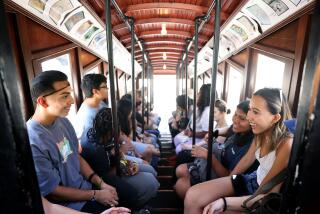Writing English : Innovative Program Makes It a 2nd Dialect for Mexican-Americans
FULLERTON — Maria Montano-Harmon’s passion for teaching was ignited in 1954 in a coat closet-turned-classroom in the dusty copper mining town of Douglas on the Arizona-Mexico border.
She was 8, bright and bilingual when she was plucked from third grade to help new children from Mexico because none of her teachers spoke Spanish. Montano-Harmon went on to become her high school’s first Mexican-American valedictorian, later graduating from college in 3 1/2 years with bachelor’s degrees in Spanish, English and education.
Today, the award-winning assistant professor of education and linguistics at Cal State Fullerton trains teachers in a highly praised program aimed at improving the language skills of American-born children of Mexican ancestry--by far the largest single group of Latinos in California and the nation.
Her pilot project, “The Write Stuff: Literacy Across the Curriculum,” was launched last fall in two Whittier high schools with the help of a prestigious Spencer Fellowship from the National Academy of Education and the cooperation of the Whittier Union High School District.
“I always knew I wanted to make a contribution to Mexican-Americans because the community I grew up in was 90% Mexican-American,” said Montano-Harmon, whose hometown of Douglas is the border twin of Agua Prieta, Mexico. “Little did I know when I started my dissertation that I was not only going to give up my next three years, but that it would become my life’s work.”
The project is designed to attack what she believes is at the root of academic failure for many American-born students of Mexican descent.
For social, cultural and economic reasons, many of these youngsters have grown up in communities where a hybrid dialect sometimes called “Chicano English” is spoken, Montano-Harmon said. Reading often is not stressed, nor is writing. So, despite years of traditional schooling, these students continue to write as they speak even into their high school years. And they continue to get Ds and Fs on English proficiency tests.
What teachers must do, says Montano-Harmon, is realize they may be the only ones in a child’s day who will converse with them in quality English. Instead of grading these youngsters solely on grammar and punctuation, they first must make students feel comfortable with writing, then show them there is a different, more formal English for schoolwork and job-hunting.
Her method emphasizes reading and writing, but in a cooperative, group-learning approach that involves even shy students who wouldn’t raise a hand in a more traditional classroom atmosphere. Whatever the subject matter, students are asked to write about it in the same casual language they use with friends.
Next, they are asked to convey the same information in a more formal fashion as if writing a newspaper article or speech for school administrators. For many students, it means their first real exploration of form and style, of the difference between academic English and what they hear in their homes and neighborhoods. Done in a group, the lesson becomes a cooperative, non-threatening exercise that emphasizes improvement instead of failure.
“In this way, we can reaffirm what they already know, and make a safe environment for them to learn,” Montano-Harmon said. “But we also are explaining how language functions--that it isn’t a matter of right or wrong, it’s a matter of appropriateness for particular situations.”
If her program is successful in Whittier and can be used as a model for other schools as she proposed for her Spencer Fellowship, educators say it could be a key to greater achievement for Latinos. As a group, Latinos have one of the highest dropout rates in California: 29.2% for the class of 1990, and second only to blacks, for whom the dropout rate was 32.8%.
It is not just for Mexican-American students or those with limited English skills. At Pioneer and Whittier high schools, the program is being tried across all grades and ethnic groups with promising results, say teachers at both schools. Even honor students, challenged to write conversationally, are improving their writing, said Jon Horowitz, an honors physics teacher at Pioneer.
“They had to force themselves to say things such as ‘Hey, man’ and ‘goodby’ at the end of an essay,” said Horowitz, who was once the “most recalcitrant” member of the teaching team chosen to try Montano-Harmon’s methods.
Results changed his mind.
“When we first started, we had all the kids write a little sample,” Horowitz said. “Thirty-three per cent were good, 66% were bad. . . . Then we taught the kids the difference between formal and casual English. We worked with them and tested them again, and it reversed itself: 66% acceptable, 33% unacceptable.”
Montano-Harmon developed her program after concluding a massive doctoral research project in linguistics at USC. It involved essays from more than 900 students in 10 California and Arizona schools and three from schools in Mexico.
Students were asked to write about their own education. What she expected to find was that American-born students of Mexican ancestry would write in English, but would use the same patterns identified with Spanish and other Romance languages.
In fact, recent immigrants from Mexico who had been given ESL classes did follow a pattern in English that mirrored the writing of the Mexican youngsters writing in Spanish. Anglo students wrote in the straightforward style that is typical of English.
“But Mexican-American students wrote in a free-association, stream-of-consciousness style that wasn’t even on the continuum,” she said. “What I proved is that they have a literacy problem.”
Robert B. Kaplan, a professor of applied linguistics and director of the American Language Institute at USC, said her findings demonstrate what perhaps should have been obvious about Mexican-American students. Their first language is English and what they need is English-as-a-second-dialect teaching, he said.
But the findings also raise questions about African-American students who speak so-called “Black English,” and an emerging group of young Asians whose dominant language is also a dialect of English.
“You have to wonder whether schools assume that this socioeconomic group is doomed to failure anyway, so why bother to teach them anything,” said Kaplan, who was one of Montano-Harmon’s doctoral advisers.
Can her methods really help reverse the dropout rate among Mexican-American students?
Montano-Harmon answers cautiously: “In the best of all possible worlds, students will go through these classes and find that they like school. They’ll be able to write to a general audience and they will be able to pass proficiency tests. If they enjoy themselves more and succeed, maybe they’ll stick around longer, maybe even go on to college.”
More to Read
Sign up for Essential California
The most important California stories and recommendations in your inbox every morning.
You may occasionally receive promotional content from the Los Angeles Times.










